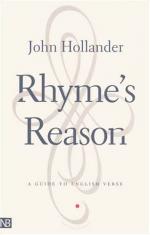|
This section contains 293 words (approx. 1 page at 400 words per page) |

|
Pure Syllabic Verse, Free Verse and Aberrant Forms Summary and Analysis
Pure syllabic verse contains lines that have a fixed number of syllables, regardless of meter. One popular form is the Japanese haiku, which has three lines of five, seven and five syllables. In English, the cinquain is traditionally a stanza of five lines with two, four, six, eight and two syllables.
The types discussed so far, pure accentual, pure syllabic and accentual-syllabic, all rely on syllables or accents to determine the length of a line of verse. There are other methods, Hollander explains. In free verse, lines can be arranged of any length and variation in the lengths can be used to create the effect the poet is after. Short lines following longer lines can add emphasis, for example, however repeating several short or long lines together...
(read more from the Pure Syllabic Verse, Free Verse and Aberrant Forms Summary)
|
This section contains 293 words (approx. 1 page at 400 words per page) |

|




